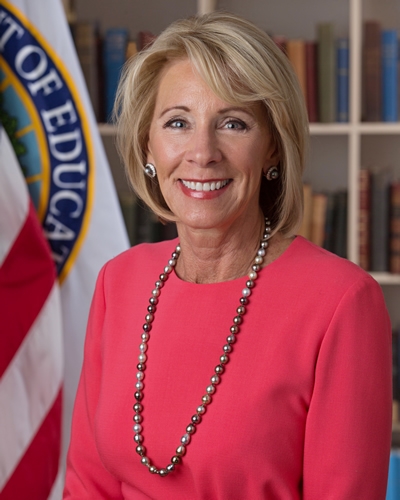You have /5 articles left.
Sign up for a free account or log in.

U.S. Education Secretary Betsy DeVos
Department of Education
College students who were brought to the U.S. illegally as children aren’t eligible for emergency aid Congress set aside in its stimulus package to help students who have experienced disruptions due to the closure of campuses during the coronavirus epidemic, the Education Department said Tuesday.
The announcement came as the department released more details about how higher education funds in the $2.2 trillion CARES Act stimulus package, approved by Congress last month, can be used.
Beyond excluding so-called DACA students, the department’s attempt to bring more clarity muddled the question of which students can get emergency help, making it even more difficult for colleges to get money in the hands of those who need it, said Terry Hartle, the American Council on Education’s senior vice president for government and public affairs.
The CARES Act had split roughly $12 billion in higher education funding, with half going to colleges and universities to help defray the financial impact of the pandemic on institutions.
The other half will go to students through emergency grants to help them pay for a variety of needs, ranging from buying tickets home after their campuses were closed to getting needed computers as courses have moved online.
In making $6.2 billion available to institutions for the emergency grants two weeks ago, U.S. Education Secretary Betsy DeVos had said she largely would leave it up to institutions to decide who’d get help.
But after colleges said they were confused about how the money could be used, the department released a question-and-answer sheet to try to add clarity. In the letter the department said the grants could only go to students who are eligible for federal aid under Title IV of the Higher Education Act. That excludes those brought to the U.S. illegally as children, who were given the right to live and work in the country lawfully under the Deferred Action for Childhood Arrivals program.
Angela Morabito, a department spokeswoman, said in an email that it was Congress’s decision to exclude DACA students. “The CARES Act makes clear that this taxpayer-funded relief fund should be targeted to U.S. citizens, which is consistently echoed throughout the law,” she said.
However, others like David Bergeron, former acting assistant secretary for postsecondary education at the department and a current senior fellow at the Center for American Progress, said the stimulus bill left the department flexibility to cover DACA students if it wanted.
Hartle agreed. "The Department of Education owns this decision. Period," he said.
Sanaa Abrar, advocacy director for United We Dream Network, which advocates for people in the DACA program, blasted the decision. "Immigrants play an essential role in our society, and now they serve as front-line workers responding to COVID-19," she said. "Yet immigrants have been largely left out of COVID-19 relief efforts."
Meanwhile, the Q&A adds confusion for campus leaders in trying to decide who can get the grants, said Daniel Madzelan, ACE's associate vice president for government and public affairs.
The section of the higher education law cited by the department’s guidance includes a host of considerations for institutions to explore before giving out the grants -- including whether students are making sufficient academic progress and whether they have ever had a drug arrest.
That’s a problem for “campuses who want to get the money out quickly but not get into trouble with the Department of Education,” Hartle said. “It was pretty clear the intent [of the CARES Act] was to get aid to all students, but this seems to narrow that more than is desirable.”
The exclusion of DACA students was disappointing to other associations representing colleges and universities, including the Association of Public and Land-grant Universities and the American Association of Community Colleges.
“As a sector, community colleges are committed to serving each and every individual who aspires to benefit from their programs,” said David Baime, AACC's senior vice president for government relations and policy analysis.
The Q&A also said, as the institutions expected, that emergency grants could not be used for a number of purposes, including paying unpaid tuition owed by students.
In some respects the department provided more clarity for institutions. DeVos also announced that she’s making available the other half of the stimulus, another $6.2 billion institutions can use to defray their own costs. And she released an agreement institutions have to sign to get the money, describing where they’re allowed to spend those funds.
One key for institutions is that they will be able to dip into the money to reimburse themselves for what they’ve already spent to give refunds to students for room and board, and other services, like internet access, that were no longer available when campuses closed. Hartle said that would help deal with institutions’ immediate need for money.
The rules also include prohibitions on using the money for certain purposes, including marketing, recruiting students, increasing endowments and building sports facilities.
DeVos, in the instructions released Tuesday, urged colleges to use as much as much of the funds earmarked for institutions as possible for emergency grant aid for students -- especially for colleges that have “significant endowment or other resources,” according to the guidance.
"This pandemic has made clear every single education institution should make important investments to ensure learning continues when unexpected circumstances arise," DeVos said in a statement. "Accordingly, the additional funds made available today can be used to expand remote learning programs, build IT capacity and train faculty and staff to operate in a remote learning environment so that at any moment institutions can pivot quickly."
Under the stimulus package, money from both funds is apportioned to colleges and universities based on a formula weighted toward institutions with the most low-income Pell Grant recipients.
Institutions have been anxious to get the money. Indeed, just a week after the stimulus package was signed into law, associations representing higher ed institutions wrote DeVos to clamor for the money to be distributed quickly.
“I fear this funding will be for naught for many institutions unless the department can act very quickly to make these funds available,” Ted Mitchell, ACE's president, wrote on behalf of the associations.








